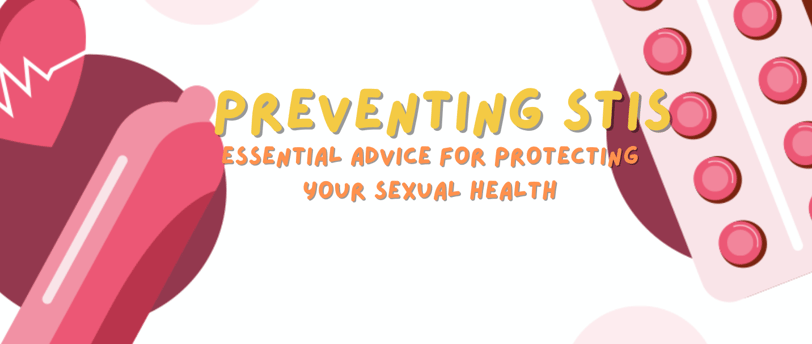Claim your free toy from Lust Collection's grand opening gift!
Preventing STIs: Essential Advice for Protecting Your Sexual Health
Sexually transmitted infections (STIs) are a significant concern for sexual health worldwide. They can impact individuals of all ages and backgrounds, making prevention a key component of maintaining overall well-being. "Preventing STIs: Essential Advice for Protecting Your Sexual Health" provides crucial information and practical tips to help you safeguard yourself and your partners from STIs, ensuring a healthier and more enjoyable sexual life.
SEXUAL HEALTH TIPS
Ms. Lusty
8/16/20243 min read


1. Understand the Risks
Knowledge is the first step in preventing STIs. Understanding the risks associated with different sexual activities can help you make informed decisions.
Know the Transmission Routes: STIs can be transmitted through vaginal, anal, and oral sex, as well as through skin-to-skin contact in some cases. Understanding how each STI is spread can guide your prevention efforts.
Recognize High-Risk Factors: Factors such as having multiple sexual partners, inconsistent condom use, and engaging in unprotected sex increase the risk of contracting STIs. Be aware of these risk factors to take appropriate precautions.
2. Use Protection Consistently
Using protection is one of the most effective ways to reduce the risk of STIs. Consistent and correct use of barrier methods is essential for protection.
Condoms: Both male and female condoms are highly effective at reducing the risk of STIs. They act as a barrier that prevents the exchange of bodily fluids and reduces skin-to-skin contact.
Dental Dams: For oral sex, dental dams can be used as a protective barrier to reduce the risk of STI transmission. They are especially useful for preventing infections in the mouth and throat.
Ensure Proper Use: Use protection consistently and correctly every time you engage in sexual activity. Follow the instructions on the packaging for optimal effectiveness.
3. Get Regular STI Screenings
Regular STI screenings are a proactive approach to sexual health, helping you identify and address infections early.
Schedule Routine Tests: Regular screenings are important, even if you don’t have symptoms. The frequency of testing depends on your sexual activity, number of partners, and risk factors. Aim for annual screenings or more often if recommended by your healthcare provider.
Discuss Testing with Partners: Communicate with your partner(s) about STI testing and share your results. Transparency helps build trust and ensures that both partners are aware of their sexual health status.
Seek Treatment Promptly: If you test positive for an STI, seek prompt medical treatment. Most STIs are treatable with medication, and early intervention helps prevent complications and further transmission.
4. Practice Safe Sex
Safe sex practices go beyond using protection and involve making informed choices about your sexual activities.
Limit the Number of Partners: Reducing the number of sexual partners can lower your risk of STIs. Being in a monogamous relationship with a partner who has tested negative for STIs can further reduce your risk.
Avoid Sharing Sex Toys: If you use sex toys, avoid sharing them with partners. If sharing is unavoidable, ensure that the toys are properly cleaned or covered with a new condom between uses.
Be Mindful of Substances: Avoid engaging in sexual activities under the influence of drugs or alcohol, as these substances can impair judgment and lead to risky behaviors.
5. Educate Yourself and Your Partners
Education plays a vital role in preventing STIs. Understanding and sharing knowledge about sexual health can enhance prevention efforts.
Learn About STIs: Educate yourself about common STIs, their symptoms, and prevention methods. Knowledge empowers you to make informed decisions and engage in safer sexual practices.
Discuss Sexual Health: Have open and honest conversations about sexual health with your partners. Discussing STIs, protection, and testing helps establish mutual understanding and respect.
Stay Informed: Keep up-to-date with the latest information on STIs and sexual health. Reliable sources such as healthcare providers and reputable organizations offer valuable insights and updates.
6. Advocate for Comprehensive Sexual Health Education
Support and advocate for comprehensive sexual health education in schools, communities, and healthcare settings.
Promote Awareness Programs: Support programs that provide accurate information about STI prevention, safe sex practices, and sexual health education.
Encourage Open Dialogue: Advocate for open discussions about sexual health in various settings, including schools, workplaces, and social groups. Creating a culture of openness helps reduce stigma and improve understanding.
Participate in Community Initiatives: Get involved in community initiatives focused on sexual health and STI prevention. Volunteering or supporting local organizations can contribute to broader public health efforts.
Conclusion
Preventing STIs is essential for maintaining sexual health and well-being. By understanding risks, using protection consistently, getting regular screenings, and educating yourself and others, you can significantly reduce your risk of STIs and promote a healthier sexual life. Embrace these essential practices to safeguard your sexual health and enjoy a fulfilling, safe, and satisfying sexual experience.
